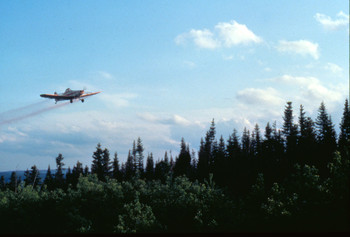Biological control using Bacillus thuringiensis (B.t.)
Bacillus thuringiensis (B.t.) is a natural spore-forming bacterium that occurs in soils everywhere. As the spore matures, it produces a protein crystal that is toxic for lepidopteran insects like spruce budworm. When larvae ingest B.t., it destroys the lining in their gut, and they stop feeding and die within days.
Developing B.t. for large-scale application

Photo showing aerial spraying
First isolated in Japan in 1901, B.t. was then recorded in a scientific description in 1911, by a researcher in Germany’s Thuringia region (giving it the scientific name thuringiensis). By the 1950s, B.t. had been registered for agricultural use in the United States, but it had not yet been tested for forestry use.
In the early 1970s, Canadian Forest Service (CFS) scientists conducted intensive research to find a way to use B.t. in forests. At the time, B.t. cost 20 times more to apply than chemical insecticides. And there were several problems that needed to be solved, such as getting the B.t. to adhere to the foliage, and determining the proper dose.
By 1980, CFS researchers had developed a formula for B.t. that would be effective and economical, and a viable alternative to synthetic chemical sprays. A key component of the formula was sorbitol, a type of corn syrup, which solved several problems. It reduced evaporation during spraying by fast and high-flying aircraft, and helped to make B.t. adhere to the needles of the trees being sprayed. Sorbitol also protected the formula from contamination and spore fermentation.
In the mid-1980s, Bacillus thuringiensis var. kurstaki (Btk) replaced chemical insecticides in aerial spraying programs for spruce budworm and other similar insects.
Ongoing improvements
Since 1985, B.t. has been used on nearly 8 million hectares of insect-infested forests. Today it is not only the most effective tool for control of spruce budworm, but also the most successful commercial product for use against forest pests, employed widely in aerial forest protection programs in Canada and throughout the world. In addition, the success of B.t. in forestry and its outstanding environmental safety have led to worldwide commercial interest in B.t. for use in agriculture and other markets.
Meanwhile, CFS research on the mode of action of B.t. at the organism and population levels has contributed to the development of improved application methods. These and other decision-support tools, which permit better spray planning, more accurate spray application and better on-target droplet deposition, will enable forest managers to use B.t. more effectively and more sparingly to protect forests during current and future spruce budworm outbreak
Canadian Forest Service key contacts
Vince Nealis, Insect Ecologist
Nicholas Conder, Research Technician - Biological Control of Defoliating Insects
- Bacillus thuringiensis (Health Canada)
Page details
- Date modified: